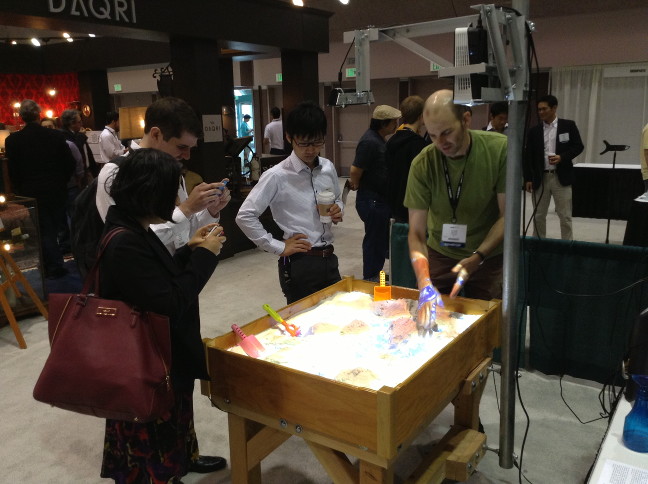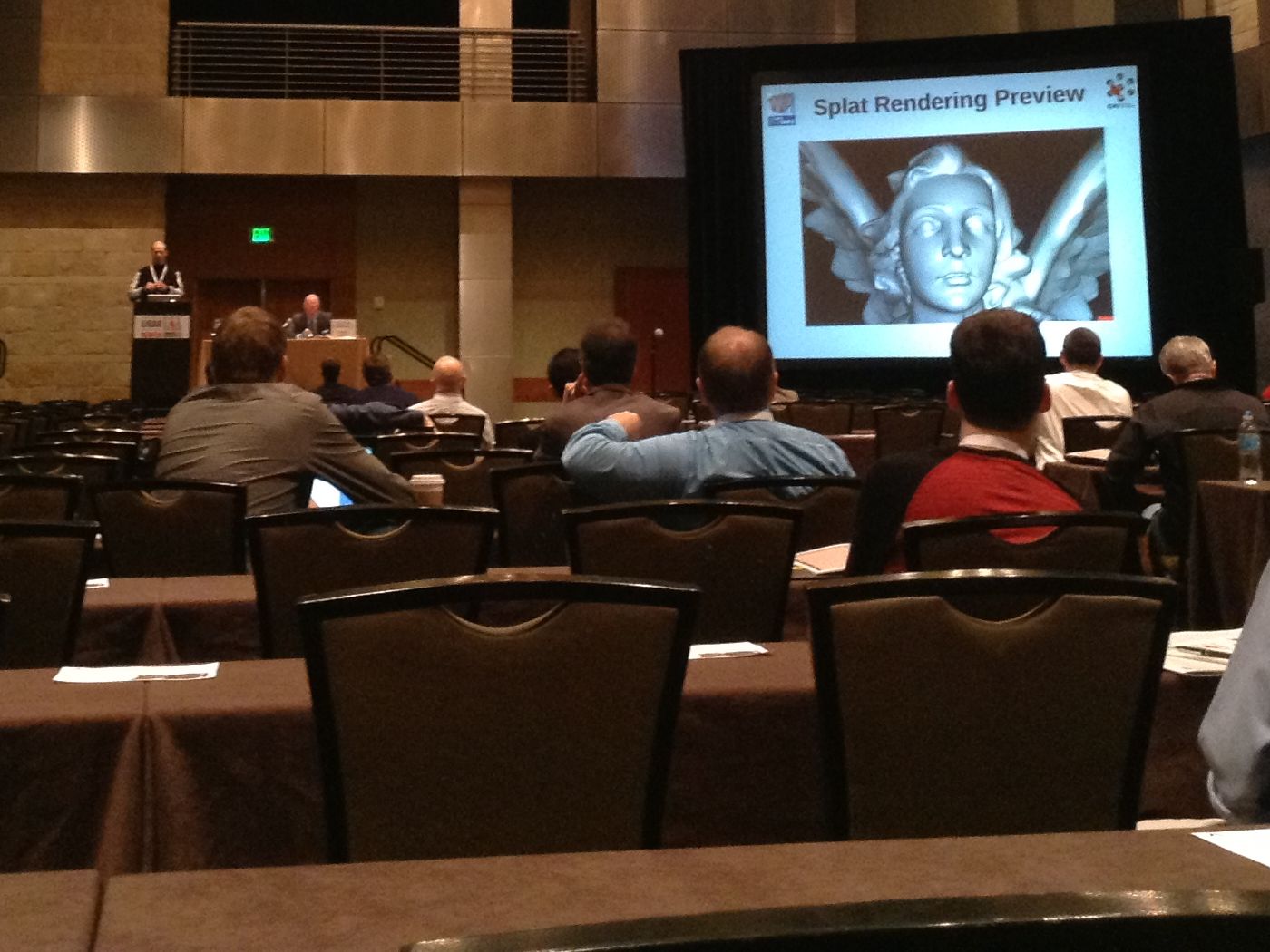I’ve just returned from the 2013 Augmented World Expo, where we showcased our Augmented Reality Sandbox. This marked the first time we took the sandbox on the road; we had only shown it publicly twice before, during UC Davis‘ annual open house in 2012 and 2013. The first obstacle popped up right from the get-go: the sandbox didn’t fit through the building doors! We had to remove the front door’s center column to get the sandbox out and into the van. And we needed a forklift to get it out of the van at the expo, but fortunately there were pros around.
Category Archives: VR Software
Behind the scenes: “Virtual Worlds Using Head-mounted Displays”
“Virtual Worlds Using Head-mounted Displays” is the most complex video I’ve made so far, and I figured I should explain how it was done (maybe as a response to people who might say I “cheated”).
Continue reading
The reality of head-mounted displays
So it appears the Oculus Rift is really happening. A buddy of mine went in early on the kickstarter, and his will supposedly be in the mail some time this week. In a way the Oculus Rift, or, more precisely, the most recent foray of VR into the mainstream that it embodies, was the reason why I started this blog in the first place. I’m very much looking forward to it (more on that below), but I’m also somewhat worried that the huge level of pre-release excitement in the gaming world might turn into a backlash against VR in general. So I made a video laying out my opinions (see Figure 1, or the embedded video below).
Intel’s “perceptual computing” initiative
I went to the Sacramento Hacker Lab last night, to see a presentation by Intel about their soon-to-be-released “perceptual computing” hardware and software. Basically, this is Intel’s answer to the Kinect: a combined color and depth camera with noise- and echo-cancelling microphones, and an integrated SDK giving access to derived head tracking, finger tracking, and voice recording data.
Virtual clay modeling with 3D input devices
It’s funny, suddenly the idea of virtual sculpting or virtual clay modeling using 3D input devices is popping up everywhere. The developers behind the Leap Motion stated it as their inspiration to develop the device in the first place, and I recently saw a demo video; Sony has recently been showing it off as a demo for the upcoming Playstation 4; and I’ve just returned from an event at the Sacramento Hacker Lab, where Intel was trying to get developers excited about their version of the Kinect, or what they call “perceptual computing.” One of the demos they showed was — guess it — virtual sculpting (one other demo was 3D video of a person embedded into a virtual office, now where have I seen that before?)
So I decided a few days ago to dust off an old toy application (I showed it last in my 2007 Wiimote hacking video), a volumetric virtual “clay” modeler with real-time isosurface extraction for visualization, and run it with a Razer Hydra controller, which supports bi-manual 6-DOF interaction, a pretty ideal setup for this sort of thing:
Low-cost VR for materials science
In my ongoing series on VR’s stubborn refusal to just get on with it and croak already, here’s an update from the materials science front. Lilian Dávila, former UC Davis grad student and now professor at UC Merced, was recently featured in a three-part series about cutting-edge digital research at UC Merced, produced by the PR arm of the University of California. Here’s the 10-minute short focusing on her use of low-cost holographic displays for interactive design and analysis of nanostructures:
On the road for VR part II: Tahoe Environmental Research Center, Incline Village, Lake Tahoe
We have been collaborating with the UC Davis Tahoe Environmental Research Center (TERC) for a long time. Back in — I think — 2006, we helped them purchase a large-screen stereoscopic projection system for the Otellini 3-D Visualization Theater and installed a set of Vrui-based KeckCAVES visualization applications for guided virtual tours of Lake Tahoe and the entire Earth. We have since worked on joint projects, primarily related to informal science education. Currently, TERC is one of the collaborators in the 3D lake science informal science education grant that spawned the Augmented Reality Sandbox.
The original stereo projection system, driven by a 2006 Mac Pro, was getting long in the tooth, and in the process of upgrading to higher-resolution and brighter projectors, we finally convinced the powers-that-be to get a top-of-the line Linux PC instead of yet another Mac (for significant savings, one might add). While the Ubuntu OS and Vrui application set had already been pre-installed by KeckCAVES staff in the home office, I still had to go up to the lake to configure the operating system and Vrui to render to the new projectors, update all Vrui software, align the projectors, and train the local docents in using Linux and the new Vrui application versions.
Meet the LiDAR Viewer
I’ve recently realized that I should urgently write about LiDAR Viewer, a Vrui-based interactive visualization application for massive-scale LiDAR (Light Detection and Ranging, essentially 3D laser scanning writ large) data.

Figure 1: Photo of a user viewing, and extracting features from, an aerial LiDAR scan of the Cosumnes River area in central California in a CAVE.
I’ve also realized, after going to the ILMF ’13 meeting, that I need to make a new video about LiDAR Viewer, demonstrating the rendering capabilities of the current and upcoming versions. This occurred to me when the movie I showed during my talk had a copyright notice from 2006(!) on it.
AR Sandbox news
The first “professionally built” AR sandbox, whose physical setup was designed and built by the fine folks from the San Francisco Exploratorium, arrived at its new home at ECHO Lake Aquarium and Science Center.

Figure 1: Picture of ECHO Lake Aquarium and Science Center’s Augmented Reality Sandbox during installation on the exhibit floor. Note the portrait orientation of the sand table with respect to the back panel, the projector tilt to make up for it, and the high placement of the Kinect camera (visible at the very top of the picture). Photo provided by Travis Cook, ECHO.
On the road for VR (sort of…): ILMF ’13, Denver, CO
I just returned from the 2013 International LiDAR Mapping Forum (ILMF ’13), where I gave a talk about LiDAR Viewer (which I haven’t previously written about here, but I really should). ILMF is primarily an event for industry exhibitors and LiDAR users from government agencies or private companies to meet. I only saw one other person from the academic LiDAR community there, and my talk stuck out like a sore thumb, too (see Figure 1).





